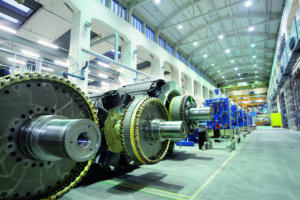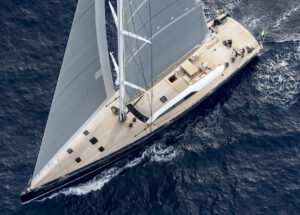
All new arrivals have stayed
Are investments made by foreign companies a threat or an opportunity? On the west coast of Finland, investments by large international companies have always been considered positive, and they are an important reason for the region’s economic success.
Chairman of the Board of The Switch, Hiroyuki Ougi, and CFO Dag Sandås are in high spirits. Their board meeting has just ended and the economic data for The Switch show that its turnover has grown considerably. One explanation for the growth is the change of ownership in 2014, when the giant of electronics, Yaskawa Electric Corporation, bought the Vaasa-based producer of electric drive solutions, The Switch.
“Without Yaskawa’s involvement, The Switch would not have seen the double digit growth it has over the last few years. It has made it easier for us to approach new and larger customers. In addition, the strong financial support gives us the freedom to develop our operations,” says Dag Sandås.
Yaskawa’s acquisition of The Switch has already proven a profitable investment, but the company’s Senior Vice President, Hiroyuki Ougi, sees other advantages in it too.
“It has given us a foothold in the wind and marine business, for example, and allowed us to expand our operations in Europe. I doubt this would have been possible without The Switch’s startup-like and flexible mode of operation and excellent technology,” Ougi says.
The acquisition of The Switch by a foreign company is one of the latest large investments made in Finland’s west coast, but the region has been attracting investors for several decades. The first large foreign investment in the area occurred in 1987 when the Swiss giant ABB bought the Strömberg factories and business operations. In retrospect, the effects of the transaction have been considerably more extensive than they originally seemed.
At first, there was a great deal of worry about the future and whether the multinational company would transfer its Vaasa plant elsewhere. However, people in Vaasa quickly realised that the best way to fight for their jobs was to try and do them as well as possible. Now, 30 years later, we can safely say that there was nothing to worry about – ABB is still the largest private employer in the city. The company has concentrated many of its strategically important product development and production activities in Vaasa, such as the development of smart grids. The general view in the region is that ABB has played a crucial role in opening up international sales channels to products made in Vaasa.
ABB’s successful investment has also been a signpost to others, because many other large international companies have since become established in the area. It is noteworthy that all the large companies that have invested in the region have stayed and developed their local operations further. Although it is difficult to speculate what the region would be like without the foreign investments, the decision-makers in the area are unanimous in their belief that the region has seen greater progress than it would have without foreign capital. According to Regional Mayor of Central Ostrobothnia, Jukka Ylikarjula, the Kokkola region would look remarkably different today without the extensive structural changes that took place in the 1990s as a result of investments by foreign companies, especially in the chemical industry.
“The success of Central Ostrobothnia was made possible by the significant modernisation of operations some twenty years ago. Without those reforms and intense development activities, many companies’ activities would have dwindled and the whole region would look very different today,” says Ylikarjula.
Ylikarjula emphasises the importance of the persevering work done in the region as an incentive for other large companies to enter the area too.
“As early as the 1990s, the opportunities offered by the global economy were recognised here. Since then, both companies and regional authorities have worked together as one to attract more foreign investments to the region.”
Regional Mayor of Ostrobothnia, Kaj Suomela, agrees. In his opinion, the intense internationalisation of the region’s companies has been a key factor in their success.
“The influence has worked both ways – foreign owners have brought money, know-how and new markets to the region, which in turn has helped Finnish companies and the whole region to develop and attract yet more investors,” Suomela explains. He sees it as a set of complicated chains where one link affects another.
“It’s not just a question of developing individual companies; instead, success always has a huge effect on other sectors, such as education and research. Over the last decades, these functions have been developed intensely as well.”
You will hear similar opinions about foreign investors if you talk to a managing director or employee of a subcontracting company or a resident of the region. Their experiences are overwhelmingly positive and they consider the presence of the foreign companies established in the region as favourable to the whole region’s commercial and industrial life. There are many statistics and indicators that support these views – the west coast is number one in Finland for exports and financial forecasts are very promising. Unemployment figures are among the lowest in the country and the region’s demography is considerably more international than the average in Finland.
The success of Ostrobothnia and Central Ostrobothnia against benchmarks of exports and internationalisation has also been observed at a national level. Minister of Economic Affairs, Mika Lintilä, describes the region as one of exports and says its success is the result of a diverse economic structure, but also the ability to base industrial activities on its strengths.
“The Vaasa region is well known as the largest energy cluster in the Nordic countries and the Kokkola region is home to the most important hub of inorganic chemical industry in Northern Europe. The global demand for sustainable solutions is growing all the time and the region’s companies are trailblazers in developing such solutions,” says Minister Lintilä.
In addition to these global clusters, the region has many smaller hubs of expertise. For example, the metal industry is strong here and many companies in the sector act as subcontractors to large export companies. Collaboration brings companies mutual benefits – for many of the region’s smaller companies, the international companies are not only customers but also indispensable partners in product development. For large companies, on the other hand, finding subcontracting partners in the same region is a huge advantage, complemented by a skilful workforce.
Another reason for the region’s success is the proportion of small and medium-sized enterprises which is among the highest in the country. Many of the region’s companies, which are now part of a big corporation, began as startups founded by local experts. Examples of these include Vacon, which was acquired by Danfoss, and The Switch, now owned by Yaskawa.
“The acquisitions have created a lot of capital, which has been returned to benefit the region’s development with new investments and startups,” concludes Kaj Suomela.

2004
Boliden buys Outokumpu’s zinc factory
Boliden Kokkola continues the zinc production started by Outokumpu and today it is the second largest zinc factory in Europe. The factory employs roughly 550 people.

2007
Kemira GrowHow is sold to Yara International ASA
Yara is a global company whose Kokkola plants manufacture fertilisers and animal feed phosphates. The company has invested heavily in the Kokkola factory’s operations throughout its period of ownership.

1987
ABB comes to Vaasa
When ABB bought Strömberg in 1987, the factory’s exports more than doubled in three years. Today, ABB’s Vaasa unit is, among other things, responsible for the manufacture of the Group’s low voltage motors worldwide, as well as the product development of these motors for demanding uses.

1998
Ferragamo buys Nautor
Known as a producer of luxury products, Ferragamo became the majority owner of Nautor, the manufacturer of luxurious Swan yachts, some twenty years ago. With the new owner, the company’s innovations and product development stepped up a gear, and today Nautor is a leader in the luxury sailing yacht market.
2013
OMG is sold to Freeport Cobalt
Founded by Outokumpu in 1967, the cobalt factory in Kokkola is now owned by the American company Freeport Cobalt. Freeport Cobalt is investing heavily in local research and development and has built, for example, a factory for the production of battery chemicals in Kokkola.

2013
Ottobock takes the reins at Baltic Yachts
Today, the German Ottobock Group owns 80% of the luxury yacht manufacturer Baltic Yachts’ shares and is closely involved in developing the company. Founded in 1973, the Baltic’s operations are steadily growing.
 2014
2014
Vacon is now Danfoss
Vacon, the manufacturer of frequency converters, was established in 1993 by a group of local experts. In 2014, the Danish company Danfoss made a bid for the company’s shares and now owns it entirely. The Vaasa factory plays a significant role in the manufacture and product development of Danfoss Drives.

2014
The Switch becomes a part of Yaskawa
Established in Vaasa in 2006, The Switch has seen a significant increase in its turnover and yield while owned by the Japanese company Yaskawa. The Switch has also expanded to completely new business areas.
